Emerging from the depths of 1940s and 1950s Hollywood, film noir stands as a captivating genre that weaves together the shadows of crime, the allure of mystery, and the complexities of the human psyche. Rooted in a potent fusion of literary influences and cinematic innovation, this distinct genre carved its niche in cinematic history, drawing from both classic literature and the socio-political landscape of its time.
Film noir finds its literary roots in the hard-boiled detective fiction of authors like Dashiell Hammett and Raymond Chandler, whose gritty tales laid the groundwork for the genre’s signature dark, morally ambiguous narratives. These narratives often featured flawed protagonists navigating a world of femme fatales, corrupt systems, and intricate plots.
“The term “film noir” itself was coined by the French, always astute critics and avid fans of American culture…. Under Nazi occupation, the French had been deprived of American movies for almost five years; and then they finally began to watch them in late 1945; they noticed a darkening not only of mood but of subject matter.”
From the book Film Noir (2004) by Alain Silver & James Ursini
In the visual realm, film noir was born from a convergence of influences, such as German Expressionism’s stark lighting and ominous visuals, and the social disillusionment mentality of post-war America. Its visual style, characterized by stark contrasts of light and shadow combined with askew framing, showcased the psychological turmoil of characters and mirrored the moral ambiguity pervading society.
Through its evocative storytelling and visual techniques, film noir became a reflection of the societal anxieties and uncertainties of its era, while simultaneously shaping the landscape of Hollywood cinema. This in turn influenced British and French cinema and its impact remains imprinted on the international cinematic tapestry, continuing to inspire and intrigue audiences, serving as a timeless testament to the artistic fusion of literature and film.
Without further ado, let’s dive straight in and go through the alphabet in our list of significant film noir movies that all fans of classic cinema should have on their watchlists…
A is for The Asphalt Jungle (1950) dir. John Huston. This quintessential film noir is credited as being one of the first ever heist movies and has been a huge influence on crime thrillers ever since.
Starring Sterling Hayden, Sam Jaffe, Louis Calhern and Jean Hagen, the plot revolves around a daring jewellery heist that goes wrong. The movie is known for its gritty portrayal of crime and its consequences.
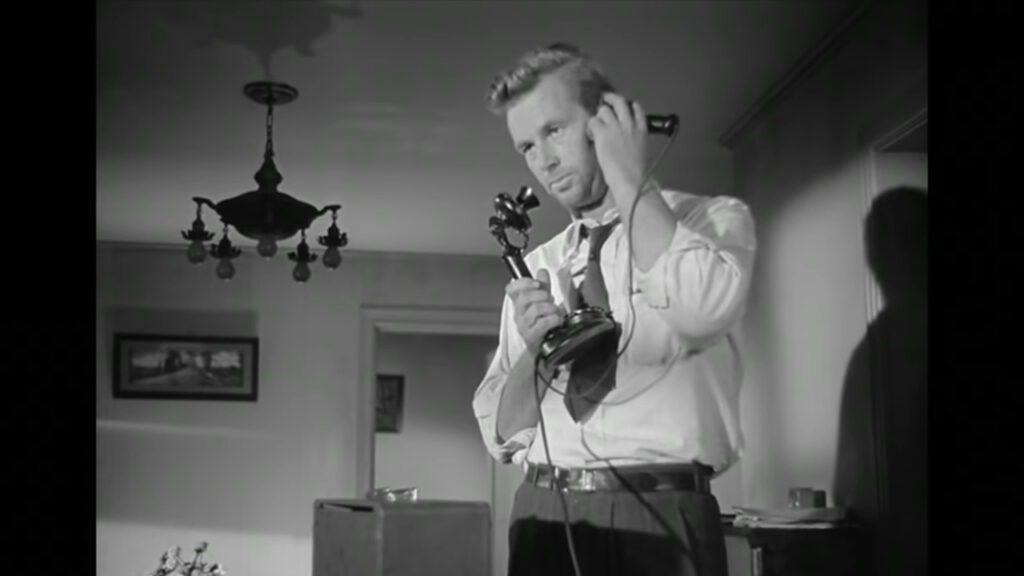
Huston’s movie is also renowned for its realistic portrayal of the criminal underworld and its characters, focusing not only on the heist itself but also on the personal lives and motivations of the individuals involved, exploring the typical film noir themes of betrayal, greed, and the cyclical nature of crime.
We highly recommend seeing this fantastic film and for more info on The Asphalt Jungle take a look at our thoughts in the Film in 5 video below!
Check out our Top 5 John Huston Films here.
B is for Bogey. Humphrey DeForest Bogart was born in New York City on Christmas Day, 1899. He would grow up to become one of the world’s most beloved and recognisable movie stars, becoming synonymous with the film noir genre having appeared in so many classics.
He often portrayed tough, cynical characters with a code of honor, and his roles in movies like The Maltese Falcon (1941), where he played the private detective Sam Spade, or The Big Sleep (1946) as Raymond Chandler’s famous gumshoe Philip Marlowe.
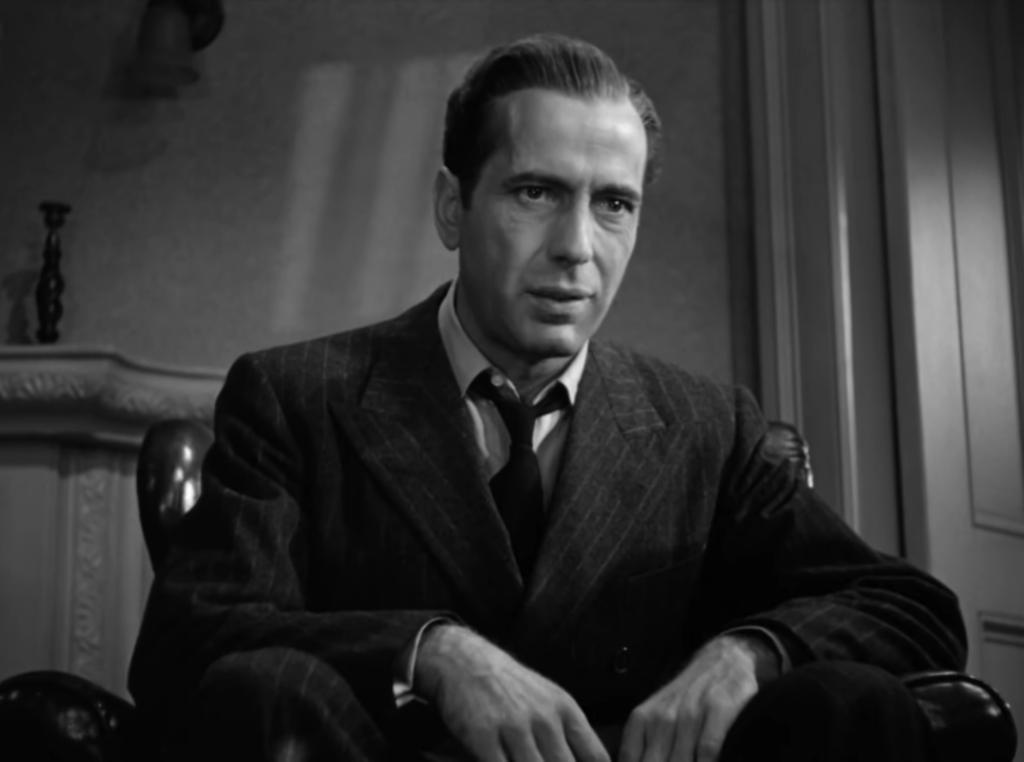
Throughout his career, Bogart’s performances were marked by his ability to bring depth and complexity to his characters, making them both tough and vulnerable. His off-screen persona, often mirroring his on-screen roles as a rugged, no-nonsense individual, added to his appeal. A prime example of this would be with his breakout role in High Sierra (1941) – check out the trailer below!
His legacy as an iconic actor continues to endure through his memorable performances, leaving an indelible mark on the history of cinema.
C is for Criss Cross (1949) dir. Robert Siodmak. This exciting film noir is known for its tense atmosphere, complex characters, and a narrative filled with betrayal and doomed romance. Its atmospheric storytelling, moral ambiguity, and compelling performances, make it a must-see for enthusiasts of classic cinema and noir aficionados.
The story follows Steve Thompson, played by Burt Lancaster, who becomes entangled in a dangerous web of love and crime. Steve is still in love with his ex-wife Anna, portrayed by Yvonne De Carlo, despite her involvement with a gangster named Slim Dundee, played by Dan Duryea.
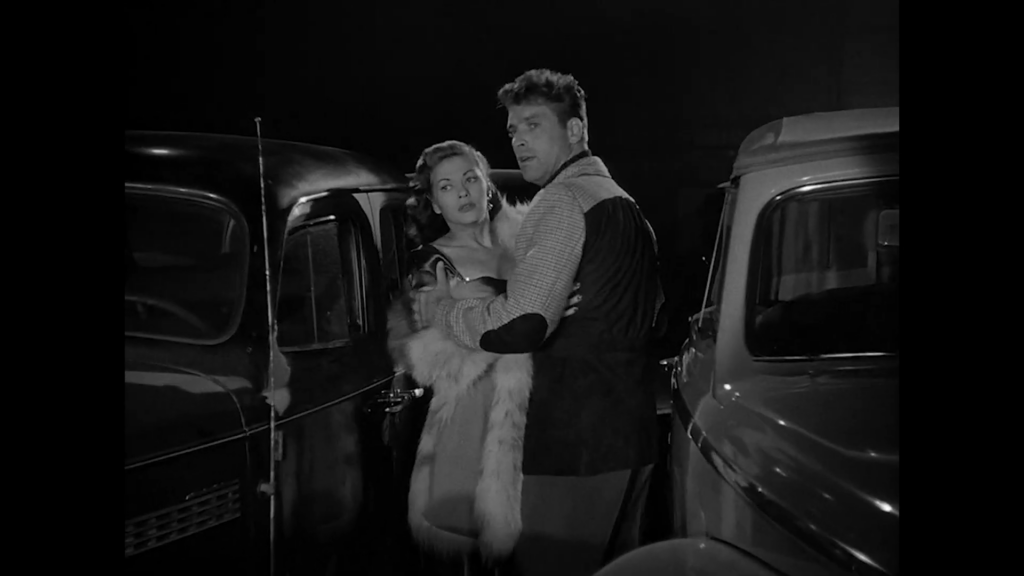
Noted for its moody cinematography, sharp dialogue, and the palpable tension created by the love triangle among Steve, Anna, and Slim, the film expertly navigates themes of fatalistic love, betrayal, and the consequences of choices made in the pursuit of desires.
The film’s non-linear narrative structure, which adds layers to the storytelling, also contributed to its noir sensibilities. Burt Lancaster’s portrayal of the conflicted Steve and Yvonne De Carlo’s performance as the enigmatic femme fatale Anna received critical acclaim for their depth and emotional intensity.
D is for Double Indemnity (1944) dir. Billy Wilder. This superbly stylish movie is viewed as an archetypal Film Noir and is often cited as being one of the finest examples of noir filmmaking to ever be produced.
Starring Fred MacMurray, Barabara Stanwyck and Edward G. Robinson, and follows insurance salesman Walter Neff, who becomes embroiled in a plot to commit murder and insurance fraud with the alluring and manipulative Phyllis Dietrichson. However, their meticulously planned crime begins to unravel as an insurance claims investigator, becomes suspicious and starts digging into the case.
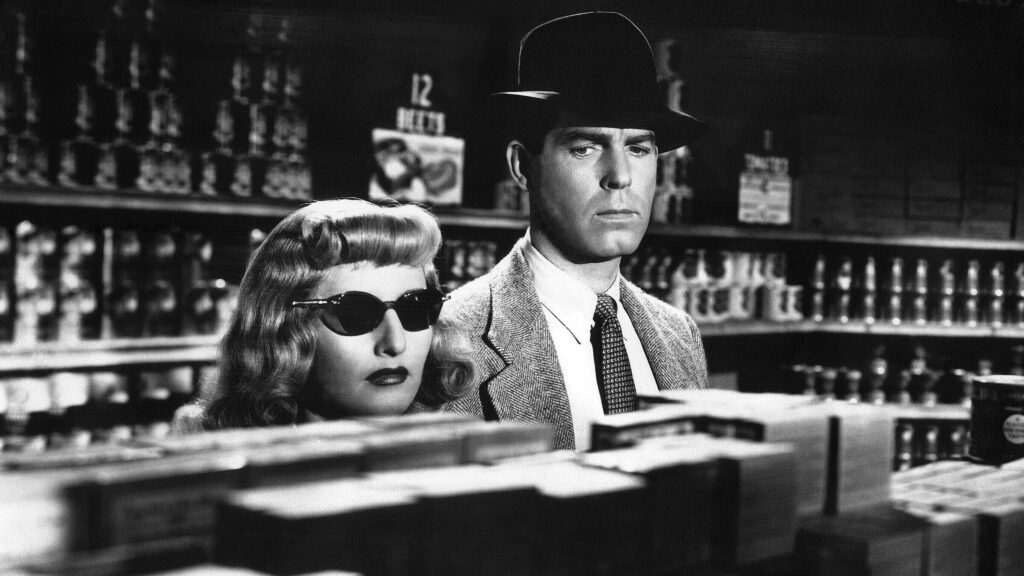
The film’s use of shadowy cinematography, clever dialogue, and a gripping narrative structure contributes to its noir atmosphere. It was one of the early examples of the genre and set a high bar for subsequent film noirs.
There’s so much to be said about this classic movie that we couldn’t possibly fit it all in to a few paragraphs. So we direct you to our podcast video below where we talk about Double Indemnity in depth.
Check out Our Top 5 Billy Wilder Films here.
E is for Edge of the City (1957) dir. Martin Ritt. This powerful film is a socially conscious drama that explores themes of friendship, racism, and standing up against injustice. The film is notable for its exploration of racial dynamics and social issues prevalent in the 1950s.
The story follows two men working on the docks in New York City: Axel Nordmann, played by John Cassavetes, and Tommy Tyler, portrayed by Sidney Poitier. Axel is a loner with a troubled past who befriends Tommy, a newcomer to the docks. Their friendship faces challenges due to the racial tensions and prejudices of the time.
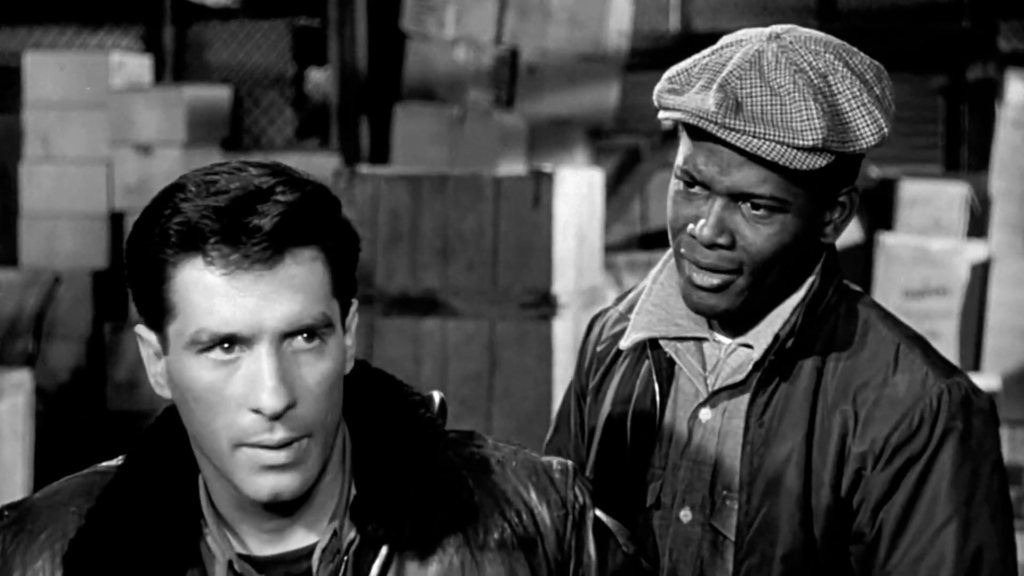
Edge of the City was one of the earlier films to address interracial friendship and societal racism directly. It’s recognized for its thought-provoking narrative and its attempt to shed light on important social issues of its time.
Though not widely recognized upon its release, this film has gained appreciation over time for its performances and its attempt to tackle significant social themes, becoming a notable entry in the realm of socially conscious movies and a unique entry in the film noir canon.
Check out Our Top 5 John Cassavetes Films here.
F is for Femme Fatale. The staple of any great film noir. The femme fatale is an embodiment of female power, seductiveness, cunning and sexuality. The term “femme fatale” is French for “fatal woman” or “deadly woman.”
Femme fatales are known for their independence, intelligence, and a sense of danger that surrounds them. They’re often morally ambiguous, blurring the lines between good and evil. Despite their captivating nature, they’re portrayed as inherently dangerous or destructive figures, leading to the downfall or ruin of those who become involved with them.
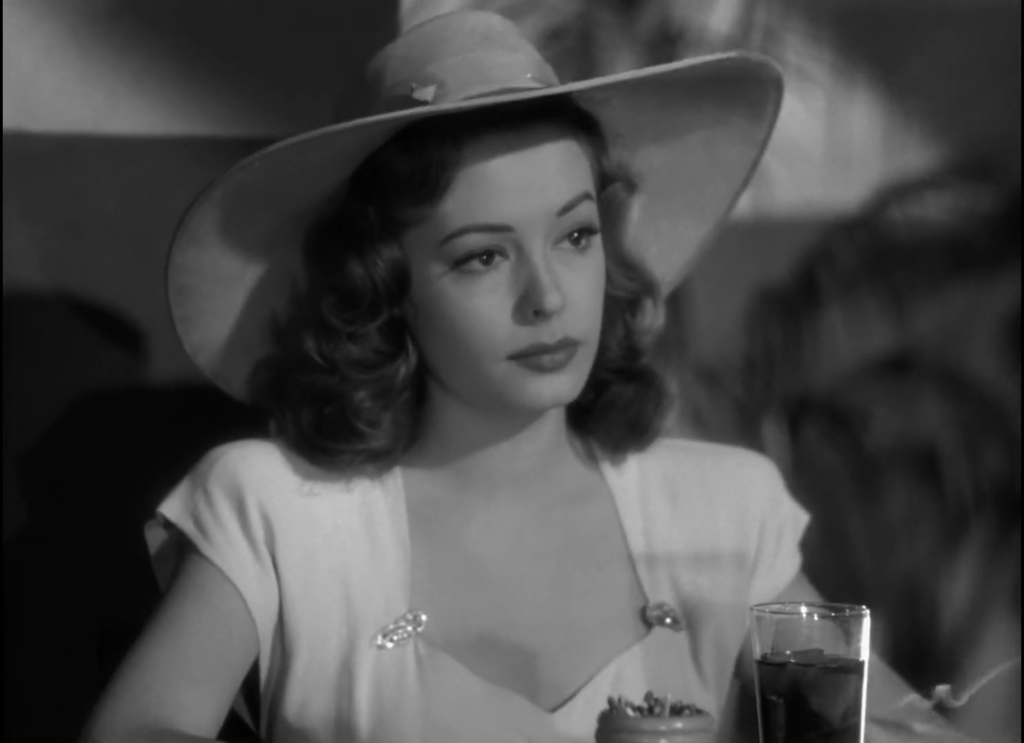
Some classic examples of femme fatales in film noir include characters like Phyllis Dietrichson in Double Indemnity played by Barbara Stanwyck, or Kathie Moffat in Out of the Past portrayed by Jane Greer. These characters are integral to the genre, embodying the dark and complex aspects of human nature, often driving the narrative and challenging the male protagonists’ morality and choices.
Check out this fascinating video below about the character Kathy Moffat by the excellent Cinema Cities.
G is for Gun Crazy (1950) dir. Joseph H. Lewis. It’s renowned for its intense portrayal of a couple consumed by their obsession with guns and crime, making it a notable entry in the genre. Starring Peggy Cummins and John Dall, this action-packed thriller is notable for its innovative cinematography, particularly its use of extended takes and a famous bank robbery sequence shot in one long take from inside a car.
The film follows Bart Tare, a troubled young man fascinated with guns from an early age. He meets Annie Laurie Starr, at a carnival. Annie is a sharpshooter and thrill-seeker, and their shared passion for guns quickly sparks a dangerous romance.
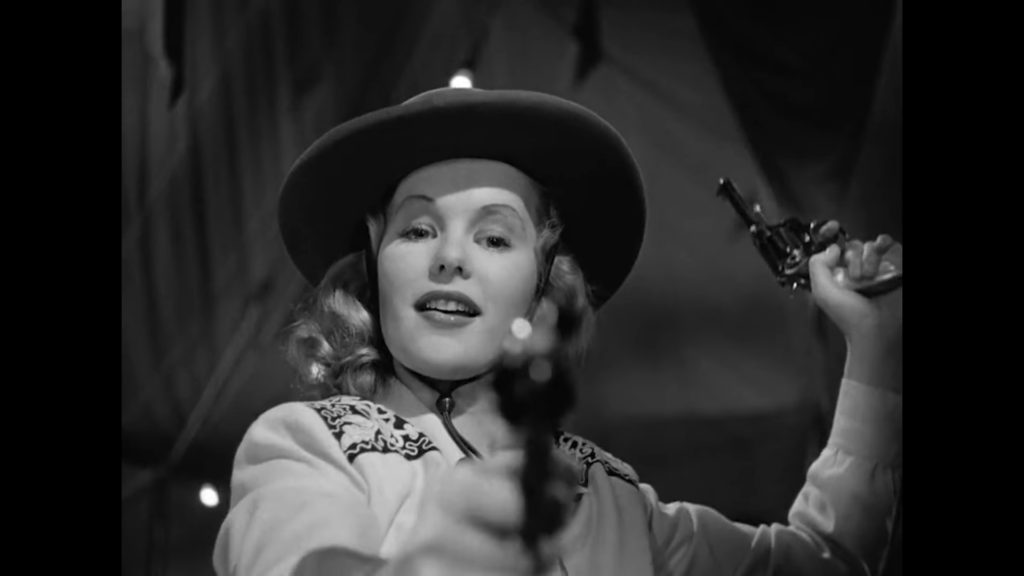
As their relationship intensifies, the couple’s fascination with firearms leads them down a path of crime. They embark on a spree of robberies, fueled by their shared obsession with guns and the adrenaline rush of danger. However, their criminal escapades ultimately lead to a downward spiral of violence and tragedy.
The film’s depiction of the darker aspects of human nature, the thrill of crime, and the destructive power of obsession makes it a striking and influential entry in the film noir oeuvre. Its daring approach to storytelling and memorable performances have solidified its place as a cult classic within the genre.
H is for Hitchcock. Often referred to as the “Master of Suspense”, Alfred Joseph Hitchcock was a prominent filmmaker known for his mastery of suspenseful storytelling and his significant contributions to the thriller and suspense genres. While Hitchcock is primarily associated with suspenseful thrillers, his work also intersects with elements of film noir, showcasing his influence on and connection to the genre.
Though Hitchcock’s films don’t always strictly fit within the classic film noir style, many of his works exhibit noir elements and themes. His visual style, characterized by the use of shadowy lighting, morally ambiguous characters, and psychological depth, often aligns with the aesthetics and storytelling conventions of film noir.
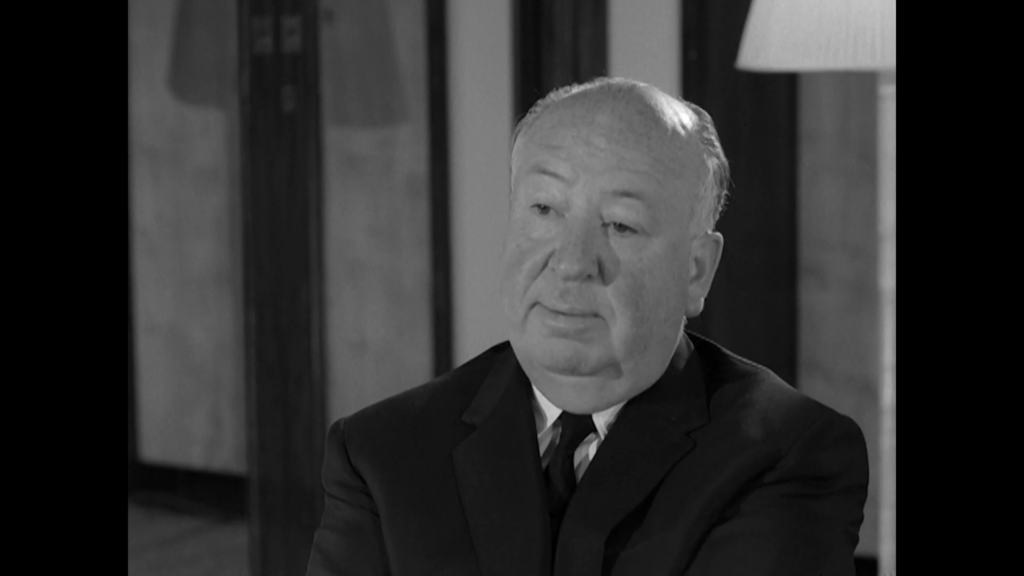
Rebecca (1940) is considered to be an early entry in the film noir canon and films like Shadow of a Doubt (1943) and Strangers on a Train (1951) exhibit strong noir elements, portraying morally complex characters navigating intricate plots and narratives driven by mystery. The movies Notorious (1946) and The Wrong Man (1956) are also considered to be strong examples of Hitchcock noirs.
Moreover, Hitchcock’s exploration of psychological depth and the darker aspects of human nature, as seen in classics like Vertigo (1958) and Psycho (1960), align with the psychological complexities often found in film noir narratives.
Here’s a list of 5 Hitchock Films You Probably Haven’t Seen, But Definitely Should.
I is for In a Lonely Place (1950) dir. Nicholas Ray. The film stars Humphrey Bogart as Dixon Steele, a troubled and volatile screenwriter with a cynical and brooding demeanor. Steele becomes a prime suspect in a murder case and develops a romantic relationship with his neighbor, Laurel Gray, portrayed by Gloria Grahame, who provides him with an alibi.
The story explores Steele’s intense and tumultuous relationship with Laurel as they navigate their personal demons and the pressures of suspicion surrounding the murder. While their connection is passionate, it becomes increasingly strained due to Steele’s erratic behavior and violent tendencies, raising doubts about his innocence.
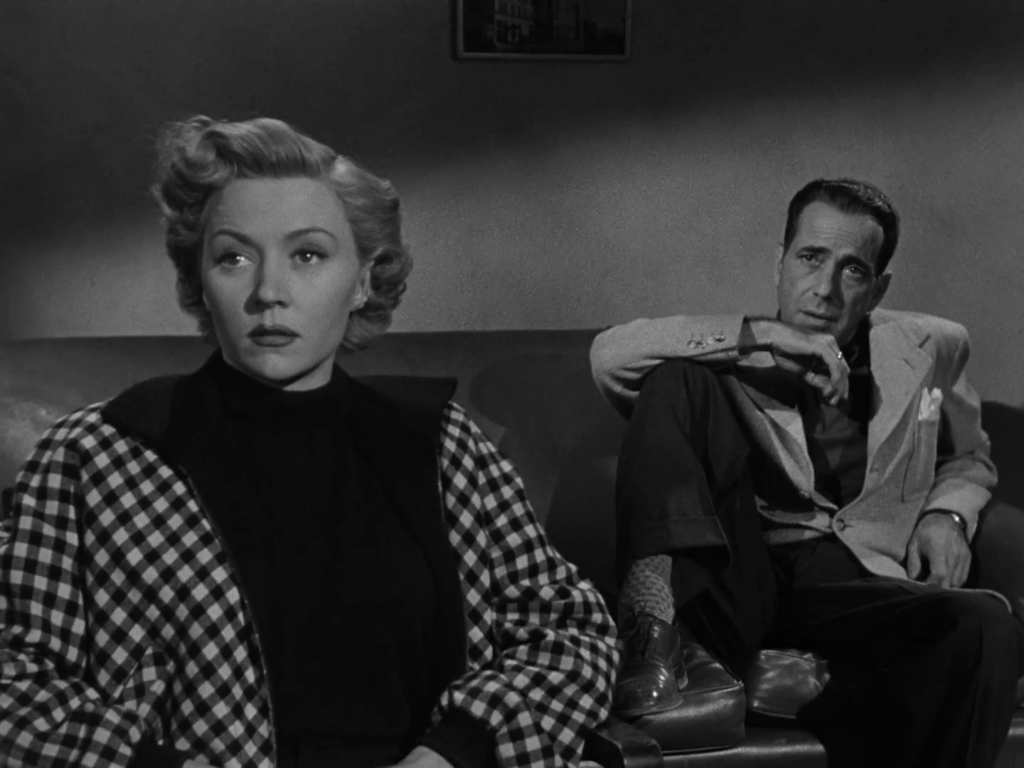
Known for its psychological depth and the examination of the darker side of Hollywood and the human psyche. In a Lonely Place explores themes of paranoia, isolation, and the destructive nature of jealousy and suspicion within relationships.
This movie is highly regarded for its unconventional approach to the noir genre, focusing more on the psychological aspects of its characters rather than the typical crime-driven narrative. Its exploration of the fragile nature of relationships and the effects of suspicion and doubt on human interactions has earned it acclaim as a thought-provoking and emotionally resonant film noir.
J is for Jigsaw (1949) dir. Fletcher Markle. The movie is structured around a series of flashbacks and presents an intricate narrative that unfolds through the perspectives of various characters involved in a murder case.
The story revolves around the murder of a wealthy and influential businessman named Charles Riggs. The film begins with the investigation into Riggs’ death, led by the determined and astute District Attorney Howard Malloy, played by Franchot Tone.
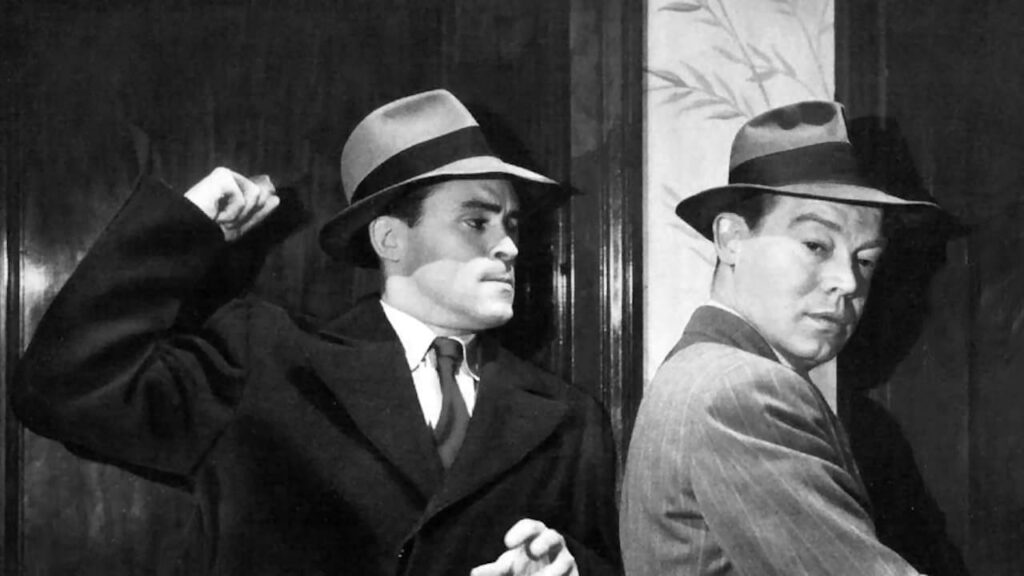
As the investigation progresses, the film delves into the lives of different individuals connected to Riggs, revealing their motives, secrets, and relationships with the deceased. The narrative is presented through a series of flashbacks, each shedding light on a specific aspect of Riggs’ life and the events leading up to his murder.
While Jigsaw may not be as widely recognized as some other film noirs from the era, its innovative storytelling and intricate plot make it an intriguing entry in the genre, offering a compelling exploration of a murder mystery from various viewpoints. Also of note is that the film has cameo appearances by Marlene Dietrich, Henry Fonda, John Garfield and Burgess Meredith.
Watch the entire film below!
K is for Kiss of Death (1947) dir. Henry Hathaway. The story follows Nick Bianco, played by Victor Mature, a career criminal who gets caught during a heist and is sentenced to prison. To secure parole and reunite with his daughters, Bianco agrees to work with the authorities to bring down a notorious criminal, Tommy Udo, portrayed by Richard Widmark in his film debut.
Widmark’s performance is particularly striking, portraying a sadistic and deranged criminal with unnerving intensity. His portrayal of Udo, especially in a famous scene involving a wheelchair and a flight of stairs, became iconic and solidified him as one of the most notable villains in cinema history.
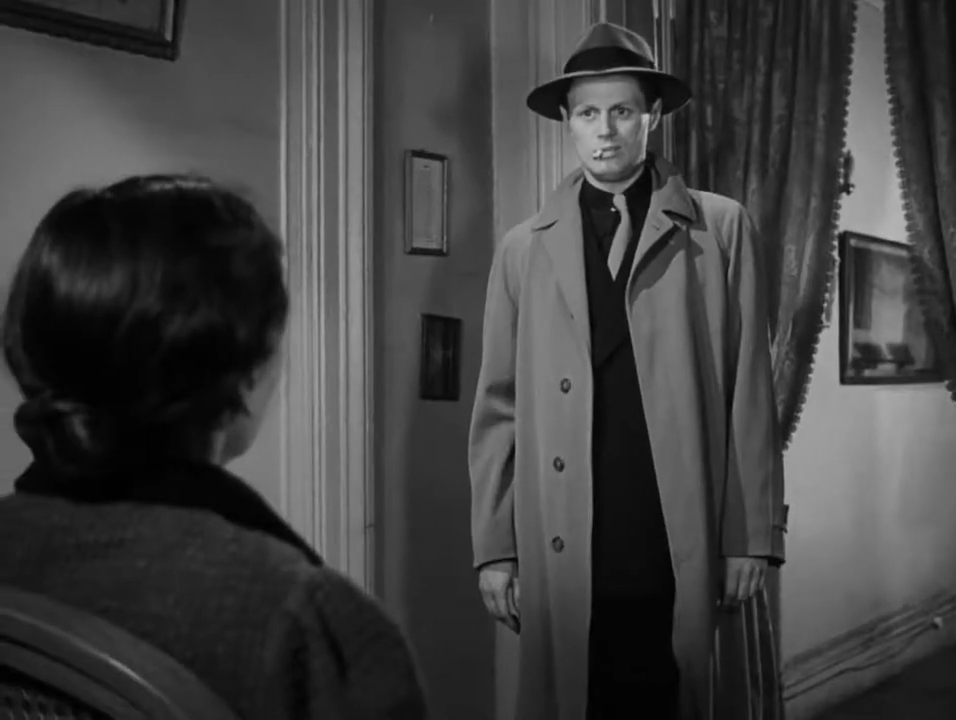
The film’s tension escalates as Bianco tries to navigate the dangers of working undercover while facing the ruthless and unpredictable Udo. Bianco’s moral dilemmas and the risks to his family add depth to the narrative, showcasing the conflict between his obligations to the law and his desire for redemption.
Kiss of Death is praised for its gritty portrayal of the criminal underworld and the moral complexities faced by its characters. The film’s use of shadowy cinematography and its exploration of themes such as loyalty, betrayal, and the thin line between law and lawlessness contribute to its status as a quintessential film noir.
L is for Leave Her to Heaven (1945) dir. John M. Stahl. Not a typical film noir by any means, this exceptional movie subverts all expectations synonymous with the genre and hides a dark undercurrent of madness that is both shocking and heart-breaking.
Starring the majestic Gene Tierney alongside Cornel Wilde, Jeanne Crain and Vincent Price, Leave Her to Heaven tells the story of Ellen Berent and her husband Richard. Despite a romantic and passionate beginning to their relationship, things quickly become strained when Ellen’s enfatuations begin to get out of hand, resulting in sinister misdeeds and terrible catastrophy.
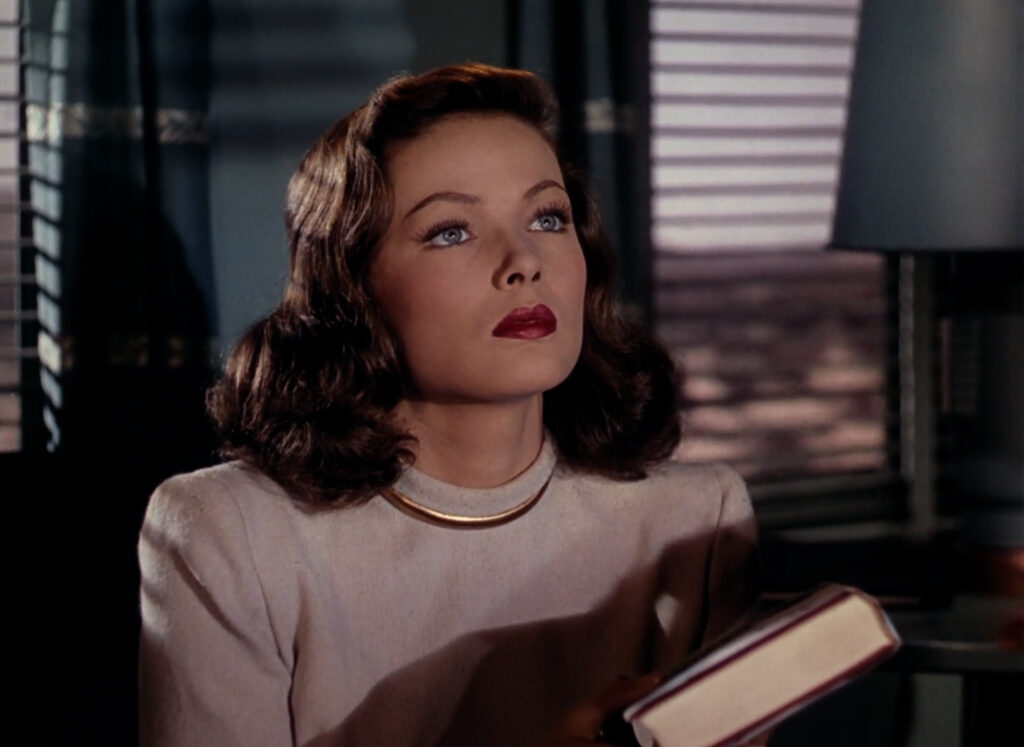
A visual treat and shot in gorgeous Technicolor, this stunning film is both beautiful and repulsive in equal measures. Gene Tierney’s mesmerizing performance as the emotionally unstable Ellen and the film’s intense exploration of psychological turmoil make it a haunting and memorable noir tale of love gone terribly wrong
We have covered this one in our Film in 5 series. Check out the video below for a more indepth look into this masterpiece of dark cinema.
M is for Mildred Pierce (1945) dir. Michael Curtiz. This classic film noir is based on the novel of the same name by James M. Cain and is known for its compelling storyline, strong performances, and its portrayal of a woman’s struggle for success and the complexities of family dynamics.
The film stars Joan Crawford as Mildred Pierce, a resilient and determined woman who divorces her husband and works tirelessly to provide a better life for her daughters during the Great Depression. Mildred starts her own successful business in the restaurant industry, but her relentless drive for success comes at a cost, affecting her relationships with her daughters and leading to personal sacrifices.
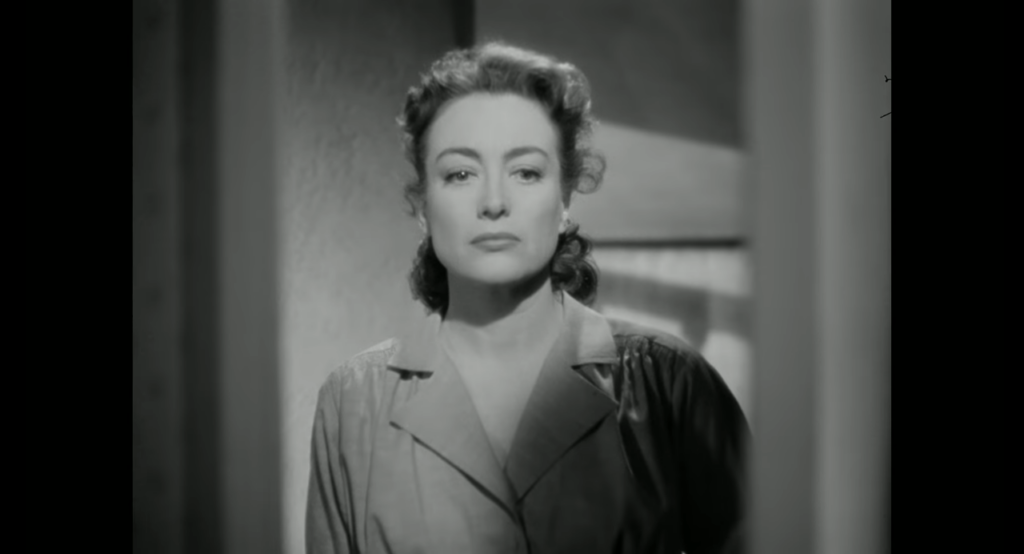
The story is a combination of drama, noir, and mystery, involving themes of ambition, love, betrayal, and class struggle. Mildred’s relationships, particularly with her daughter Veda, played by Ann Blyth, are central to the narrative. Their tumultuous dynamic becomes increasingly strained as Veda displays a manipulative and disdainful attitude toward her mother’s efforts.
Joan Crawford’s performance as Mildred Pierce earned her an Academy Award for Best Actress. Her portrayal of a strong-willed woman navigating societal challenges and personal sacrifices resonated with audiences and critics alike.
Check out our Top 5 Michael Curtiz Films here.
N is for Night and the City (1950) dir. Jules Dassin. Set in London, this American production stars Richard Widmark and Gene Tierney and is one of the most underrated film noir movies in our list. Expertly directed by Dassin, this perfectly paced crime thriller sees Widmark’s ambitious grifter claw his way to the top, only to be toppled by rotten luck, terrible choices and his own misguided need for success at any cost.
The movie is known for its atmospheric cinematography, showcasing the shadowy and gritty landscapes of London at night. It captures the sense of desperation and the characters’ moral ambiguity against the backdrop of a city teeming with corruption and danger.
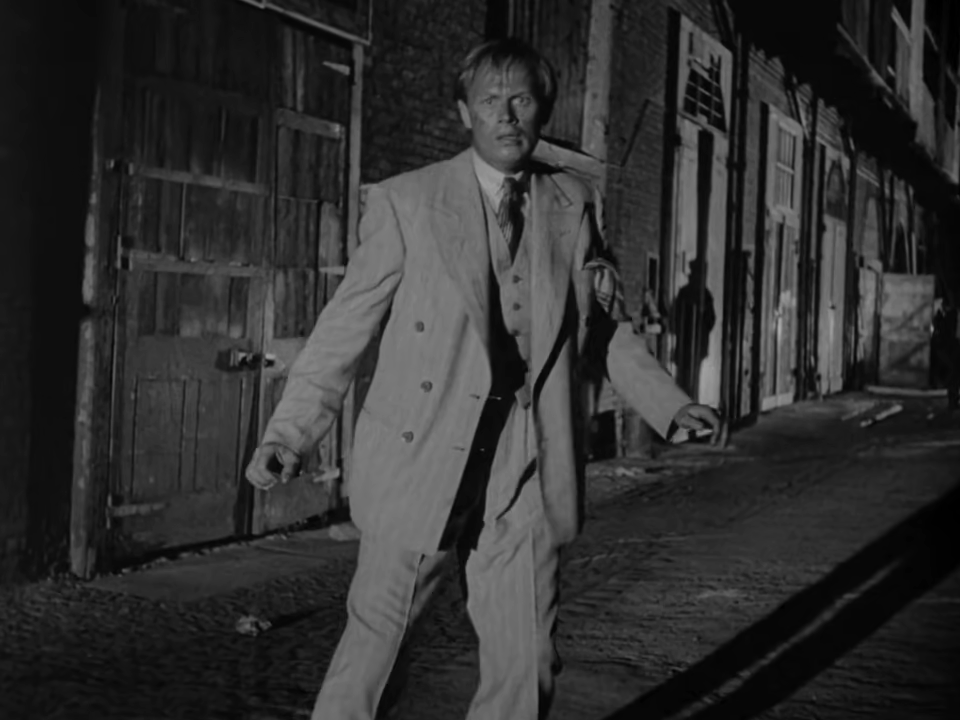
Richard Widmark delivers a compelling performance as the ambitious yet morally bankrupt protagonist, while the supporting cast adds depth to the film’s noir atmosphere. The tension and suspense build steadily throughout the narrative, culminating in a gripping and tragic climax.
Night and the City stands out for its portrayal of a man’s relentless pursuit of success in a morally bankrupt world, ultimately leading to his downfall. Its dark and gritty portrayal of urban life and its exploration of ambition, greed, and betrayal make it a classic example of the film noir genre.
O is for Out of the Past (1947) dir. Jacques Tourneur. This classic movie revolves around Jeff Bailey, played by Robert Mitchum, a former private investigator leading a quiet life in a small town, trying to escape his troubled past.
However, his past catches up with him when a criminal named Whit Sterling, portrayed by Kirk Douglas, tracks him down and pulls him back into a world of deceit and danger.
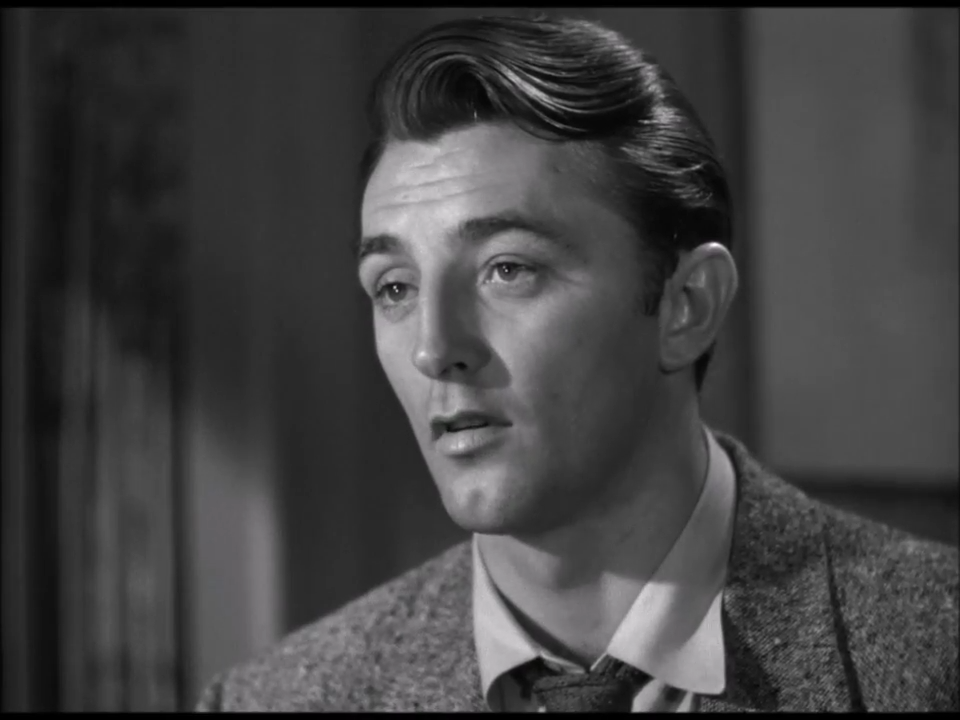
The film employs a non-linear narrative structure, with Jeff narrating his own story in a series of flashbacks that reveal his previous life as a detective hired by Sterling to find his girlfriend Kathie Moffat, played by Jane Greer. As Jeff gets entangled in a web of lies and double-crosses, his relationship with Kathie becomes the focal point, blurring the lines between love and betrayal.
Out of the Past is celebrated for its atmospheric cinematography, showcasing the dark and shadowy aesthetics characteristic of film noir. The film’s use of chiaroscuro lighting, moody settings, and morally ambiguous characters contributes to its noir sensibilities.
P is for Phantom Lady (1944) dir. Robert Siodmak. This exciting crime thriller tells the story of a woman’s quest to prove her wrongfully accused friend’s innocence. The story follows Carol Richman, played by Ella Raines, who stands by her friend Scott Henderson, portrayed by Alan Curtis, after he’s accused of murdering his wife.
Scott’s only alibi a mysterious woman wearing a distinctive hat who seems to have vanished, leaving him with no defense. Determined to clear Scott’s name, Carol embarks on her own investigation to find the elusive “phantom lady” and gather evidence to prove his innocence.
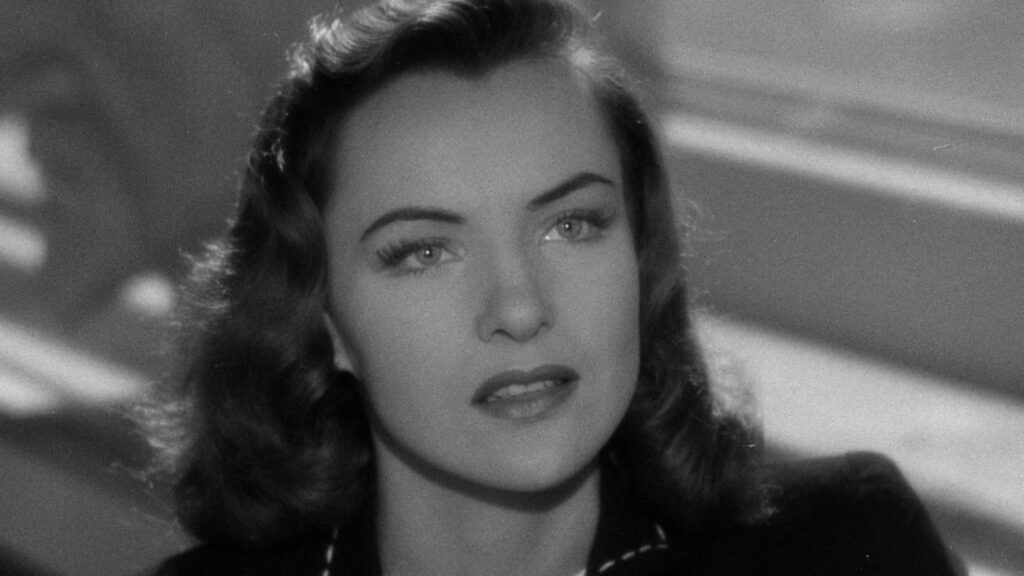
Notable for its moody cinematography, employing stark lighting and shadowy visuals characteristic of film noir. It also incorporates themes of mystery, betrayal, and the search for truth within a labyrinth of deception.
Phantom Lady is praised for its suspenseful narrative and Raines’ compelling performance as the determined and resourceful Carol. This film noir will keep in its grip as it unravels the layers of deceit and manipulation surrounding the murder case.
Q is for Quicksand (1950) dir. Irving Pichel. It stars Mickey Rooney in a departure from his usual roles, portraying a young man named Dan Brady, whose life takes a dark turn after a series of wreckless and impulsive decisions.
Brady’s actions escalate as he becomes involved with a femme fatale named Vera, played by Jeanne Cagney, who lures him into a scheme involving stolen money. His attempts to fix his mistakes only seem to worsen his situation, leading to dire consequences.

Quicksand is notable for its exploration of a regular man’s descent into a world of crime and moral ambiguity. Mickey Rooney’s portrayal of Dan Brady showcases his versatility as an actor, portraying a character grappling with his choices and the consequences of his actions.
Perhaps considered a lesser-known entry in the film noir genre, it is nevertheless appreciated for its atmospheric cinematography and the portrayal of the protagonist’s unravelling as he becomes increasingly trapped in a cycle of deceit and desperation.
Enjoy the entire movie for free right here in the video below!
R is for Rififi (1955) dir. Jules Dassin. It’s regarded as a classic in the heist genre and is known for its meticulous and tension-filled portrayal of a daring jewellery robbery. Inspired by The Asphalt Jungle, master director Dassin takes the concept to new heights in this thrilling tale of crime and treachery.
The film follows a group of criminals who plan an ambitious and meticulously detailed heist to rob a jewelry store in Paris. The heist itself is the centerpiece of the film, and what sets it apart is its meticulous depiction, showing the intricate planning and execution of the robbery in real-time without any dialogue or music. This lengthy and tension-filled sequence has become iconic in the history of cinema.
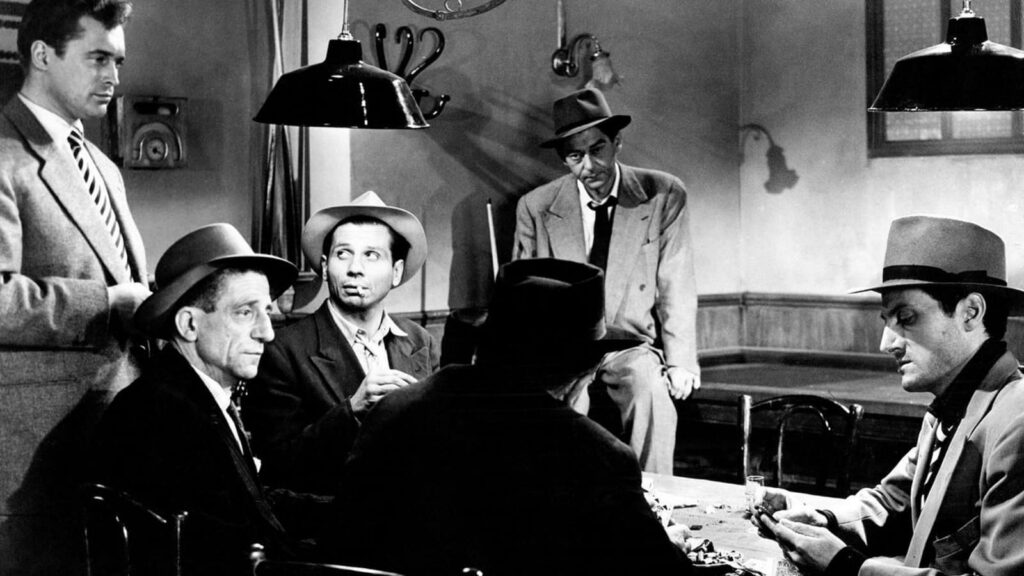
The film’s direction by Jules Dassin and its innovative approach to portraying the heist process set it apart from other heist films of the time. Despite being in French and relatively unknown upon its initial release, “Rififi” gained international acclaim for its technical brilliance, particularly in its detailed depiction of the heist, making it a significant and influential entry in the heist and film noir genres.
Representing French Noir which deserves and entire article of it’s own, this masterpiece of cinema is the perfect introduction to film noir, French style!
S is for Strangers on a Train (1951) dir. Alfred Hitchcock. This psychological thriller is adapted from Patricia Highsmith’s novel and revolves around a chance meeting between two strangers whose conversation leads to a twisted and dangerous proposition.
Hitchcock masterfully creates tension and suspense, building upon the psychological complexities of the characters. The film is known for its innovative camerawork, particularly during the climax set on a merry-go-round, which showcases Hitchcock’s skill in creating thrilling and visually captivating sequences.
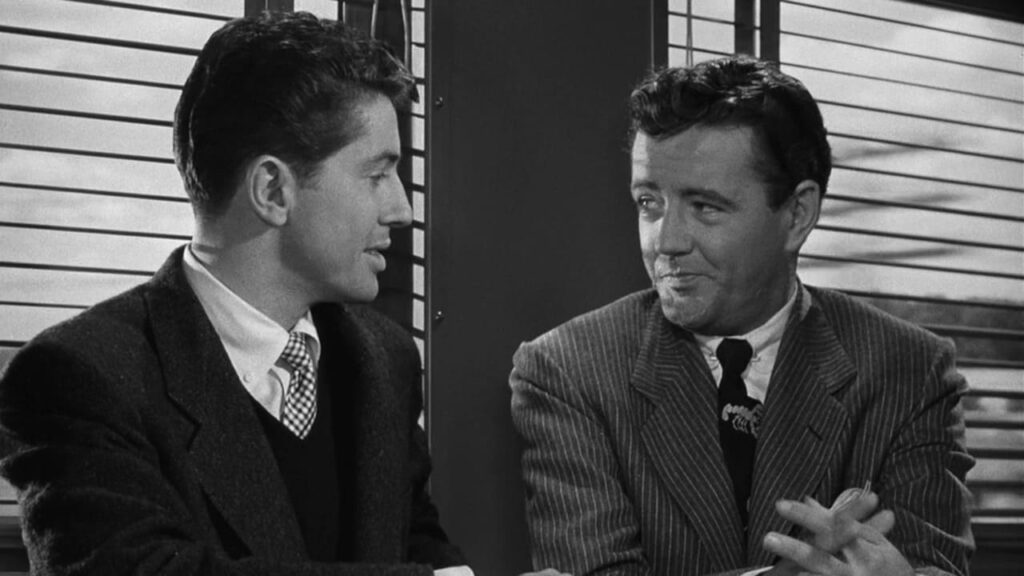
Strangers on a Train remains a classic in Hitchcock’s filmography, celebrated for its suspenseful storytelling, psychological depth, and its exploration of the blurred lines between chance, obsession, and moral responsibility.
Check out our deep dive Film in 5 video about this movie below!
T is for Touch of Evil (1958) dir. Orson Welles. Set in a fictional town on the U.S. – Mexico border, the film opens with a bomb explosion that kills a wealthy businessman. This incident draws in a Mexican narcotics officer, Mike Vargas, portrayed by Charlton Heston, and a corrupt, alcoholic police captain, Hank Quinlan, played by Orson Welles himself.
As Vargas investigates the case, he becomes entangled in a web of deceit, manipulation, and police corruption orchestrated by Quinlan. The narrative explores themes of racial tension, political corruption, and the abuse of power.
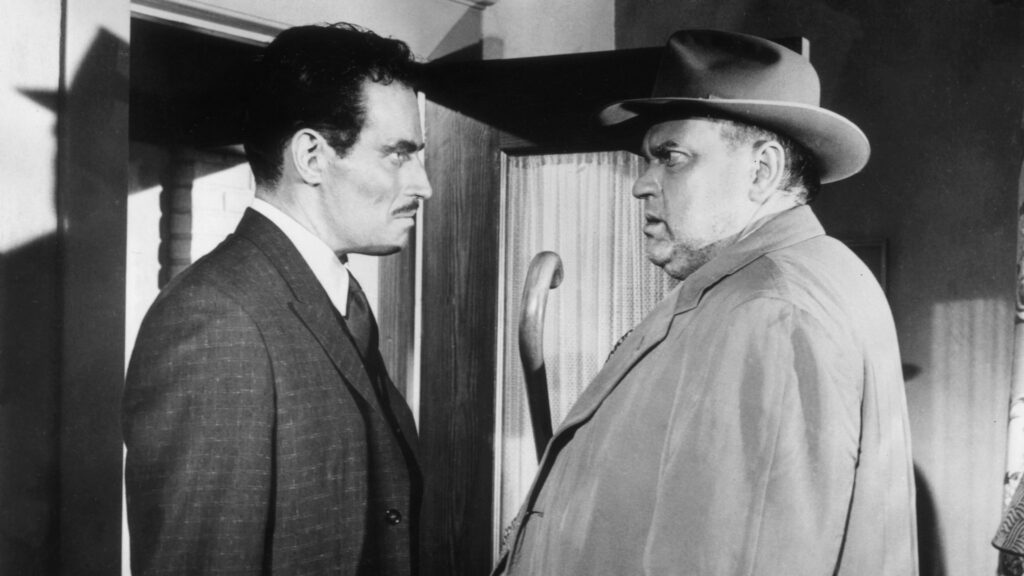
Touch of Evil is renowned for its stunning cinematography, particularly its famous opening sequence—a three-minute continuous tracking shot that follows a car rigged with a bomb. Welles’ use of deep focus, long takes, and chiaroscuro lighting techniques adds to the film’s visual intensity and contributes to its noir atmosphere.
Despite initial studio interference with the editing, resulting in different versions of the film upon release, this movie has gained recognition as a classic film noir. It’s appreciated for its bold visual style, its exploration of moral ambiguity, and its depiction of a corrupt and morally conflicted world.
Check out our deep dive Film in 5 video review below for a closer look at this excellent movie.
U is for Undercurrent (1946) dir. Vincente Minnelli. While not as well-known as some other films in the genre, it’s an intriguing psychological thriller with elements of suspense and mystery. The movie explores themes of deception, obsession, and the consequences of delving into someone’s hidden past.
The film follows Ann Hamilton, played by Katharine Hepburn, who falls in love with and marries a brilliant scientist named Alan Garroway, portrayed by Robert Taylor. Despite warnings from Alan’s brother Michael, played by Robert Mitchum, Ann goes ahead with the marriage.
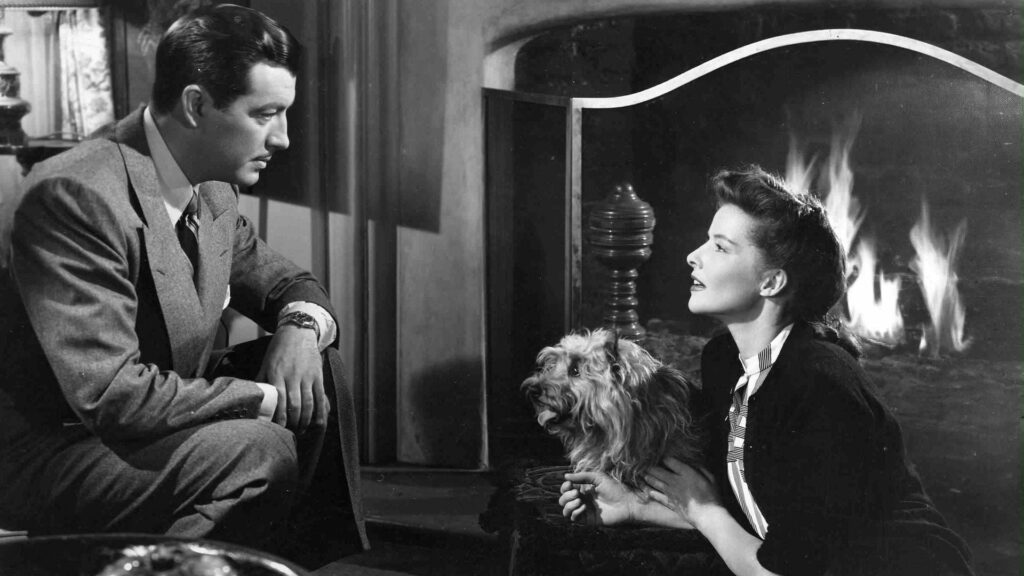
As Ann settles into her new life with Alan, she begins to sense an air of mystery surrounding him. She discovers unsettling truths about Alan’s past, including his former wife’s mysterious disappearance and the circumstances surrounding it. The discovery of a hidden secret room in their house deepens Ann’s suspicions about her husband’s true nature.
While not a typical hard-boiled crime noir, Undercurrent incorporates elements of psychological tension and a sense of foreboding, making it an interesting addition to the film noir catalogue.
V is for Voice-over. This form of narration is a distinctive feature often employed in film noir, serving as a storytelling device that offers insight into a character’s thoughts, motivations, and perspectives. The technique is frequently utilized to convey a sense of introspection, inner conflict, or moral ambiguity within the protagonist or another character.
In film noir, voice-over narration often accompanies the visuals, creating a contrast between what is seen on screen and what the character reveals through their inner monologue. This contrast adds depth to the storytelling, providing layers of information that might not be evident from the action or dialogue alone.
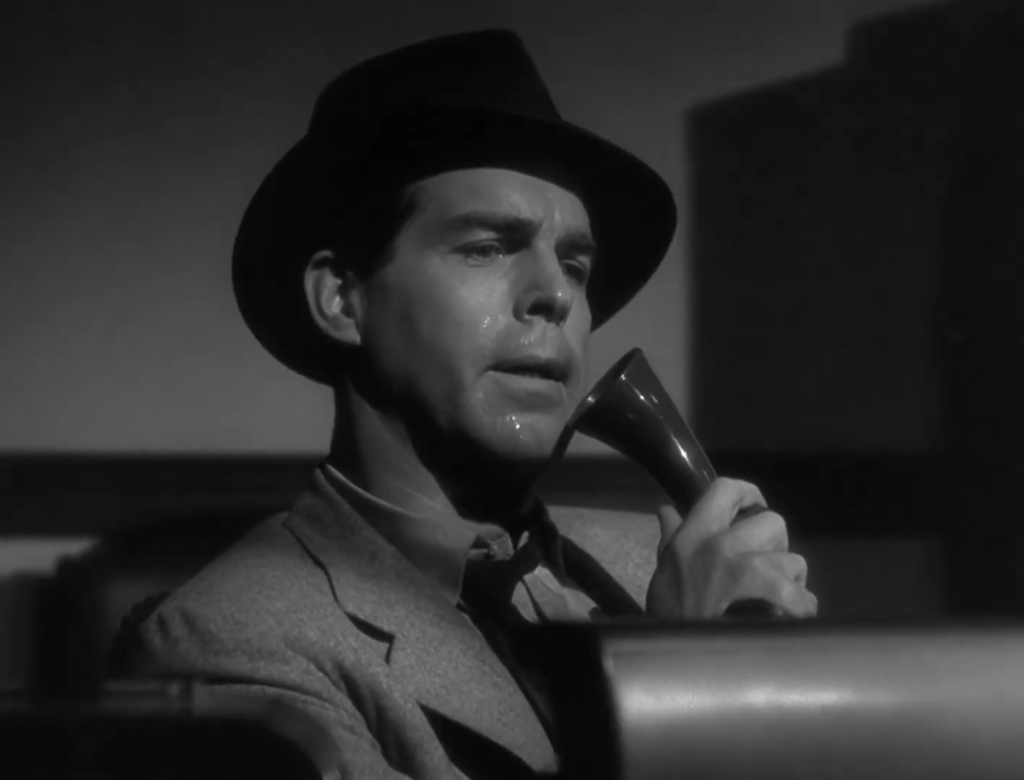
Classic examples of film noir that effectively utilize voice-over narration include Double Indemnity, The Third Man and Sunset Boulevard, where the narration serves as a window into the morally conflicted minds of the characters and adds depth to the noir atmosphere, enriching the overall storytelling experience.
W is for White Heat (1949) dir. Raoul Walsh. Thisclassic crime film star James Cagney in one of his most memorable roles. The film is known for its gritty portrayal of criminals, its psychological intensity, and Cagney’s iconic performance.
The story follows Cody Jarrett, a psychotic and ruthless criminal leader with a volatile and explosive personality. Jarrett is a ruthless gangster involved in various nefarious activities, including a series of daring robberies. He has a strong and complex relationship with his mother, which is a central aspect of the film.
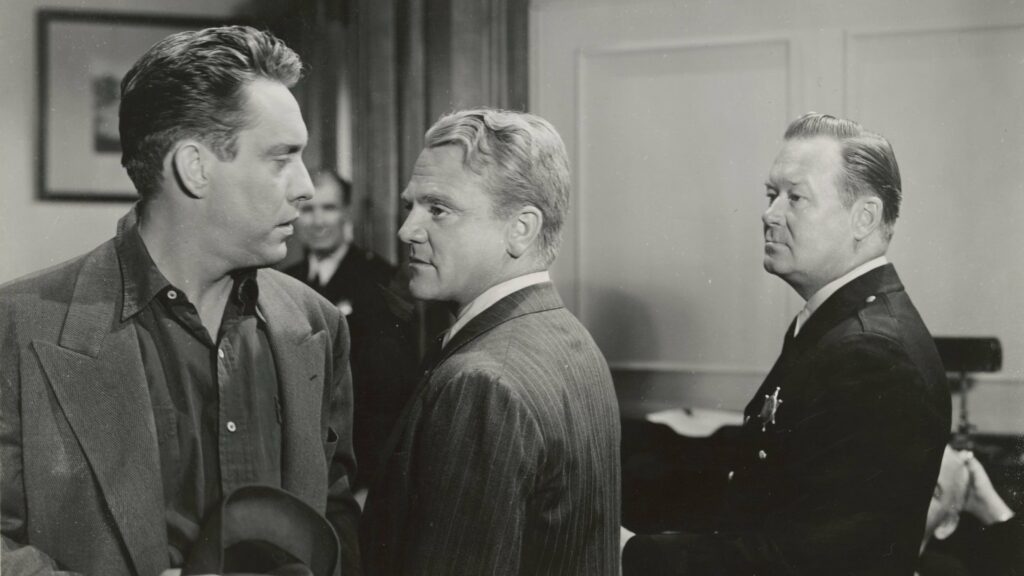
One of the most memorable scenes in the movie features Cagney’s character on top of an oil refinery tank, delivering his famous line, “Made it, Ma! Top of the world!”. The film’s intensity, combined with Cagney’s electrifying performance, has solidified this moment as an iconic piece of cinematic history.
White Heat is celebrated for its raw and unflinching portrayal of a criminal’s psyche, its suspenseful storytelling, and Cagney’s powerhouse performance. It’s considered a quintessential film noir and one of James Cagney’s most defining roles, showcasing his talent for playing complex and morally ambiguous characters.
X is for The Amazing Mr. X (1948) dir. Bernard Vorhaus. Also known as The Spiritualist in some releases, it’s a lesser-known movie that combines elements of film noir with a touch of the supernatural.
The story centers around Christine Faber, played by Lynn Bari, a grieving widow who visits a spiritual medium named Alexis, portrayed by Turhan Bey, hoping to communicate with her deceased husband. Alexis, a mysterious and seemingly clairvoyant figure, captivates Christine with his apparent ability to connect with the spirit world.
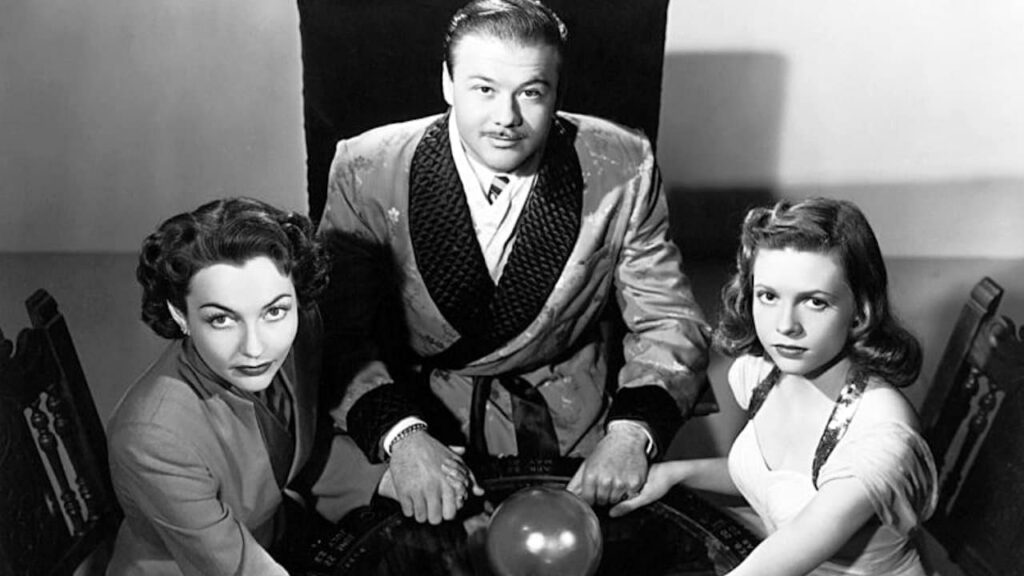
The film blends elements of mystery, suspense, and the supernatural, creating an atmosphere of uncertainty and intrigue. It’s notable for its moody cinematography and the exploration of themes surrounding spiritualism and the manipulation of vulnerable individuals seeking solace or answers.
While The Amazing Mr. X might not be as widely recognized as other films from the era, it’s appreciated by enthusiasts of both film noir and supernatural thrillers for its unique combination of genres and its exploration of mysticism and psychological manipulation within a noir framework.
Y is for You Only Live Once (1937) dir. Fritz Lang. Considered an early film noir from the German master director, this crime story stars a young Henry Fonda as Eddie Taylor, a convicted felon released on parole after serving time for a crime he didn’t commit.
Despite his efforts to lead an honest life and provide for his wife, Joan, played by Sylvia Sidney, and their unborn child, Eddie faces immense challenges due to his criminal record and the prejudices of society.
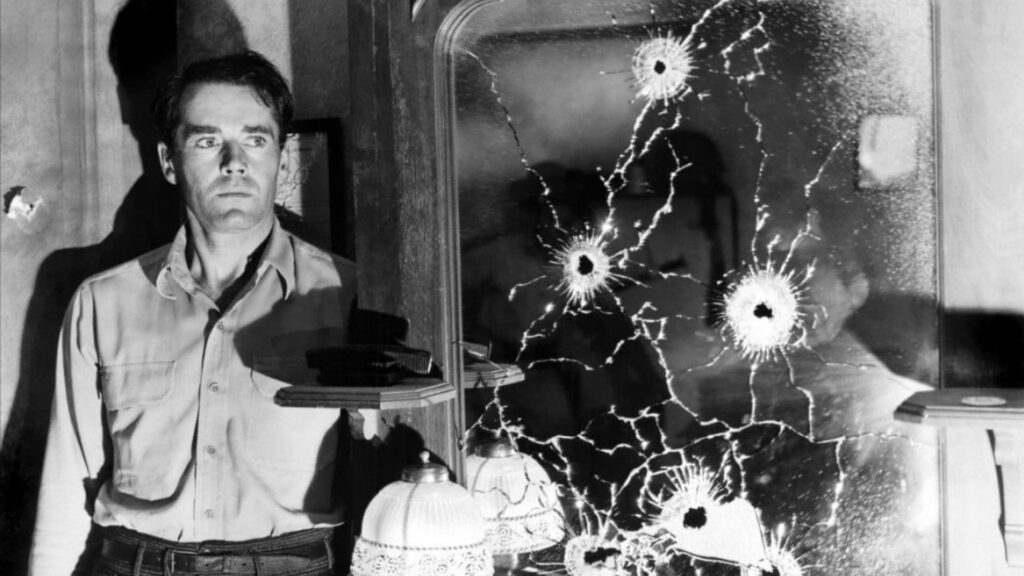
Fritz Lang’s direction infuses the film with a sense of doom and inevitability, emphasizing the couple’s struggles against a world seemingly determined to see them fail. The movie reflects the bleakness of the Great Depression era and examines themes of injustice, societal pressures, and the pursuit of redemption.
You Only Live Once stands out for its emotional depth, intense performances by Henry Fonda and Sylvia Sidney, and its exploration of the human condition amidst adversity. Its somber and tragic tone, coupled with Lang’s direction and the lead actors’ compelling portrayals, contribute to its status as a notable entry in the realm of early film noir and other crime dramas from the era.
Z is for Zero Focus (1961) dir. Yoshitarô Nomura. This Japanese mystery thriller is based on a novel by Seicho Matsumoto and is celebrated for its suspenseful storytelling and its exploration of the secrets and deceptions within a seemingly idyllic marriage.
Praised for its atmospheric direction and the building of tension and suspense as the story unfolds. The film captures the essence of post-war Japan, exploring themes of hidden secrets, societal expectations, and the struggle between appearances and reality.
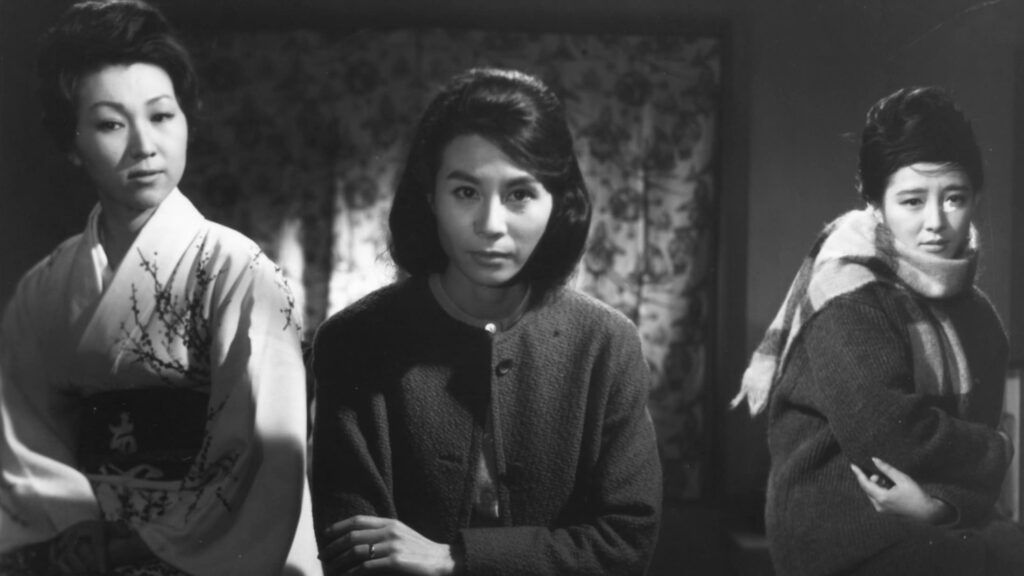
The film’s visual storytelling contribute to its noir-like atmosphere, creating a sense of unease and mystery that keeps the audience engaged throughout Teiko’s investigation. Though not a strict film noir, the influences of the genre can be identified throughout this incredible movie.
Zero Focus is regarded as a classic in Japanese cinema, known for its intricate plot, strong performances, and its adeptness at combining elements of mystery, suspense, drama and film noir to create a compelling narrative.
That’s our Movie Alphabet A-Z: Film Noir Edition!
Did you enjoy this article? Are you a film noir fan? Let us know your thoughts on this article in the comments down below!
For more episodes of More Movies Weekly as well as our other shows and podcasts, be sure to check out the Podcasts page on our website.
Remember, you can have a choice of what films we review on our Weekly podcast by joining us on Patreon here.
Please join us on social media on Facebook, Instagram, Tik Tok and Twitter. We really appreciate all the likes, shares, retweets etc., and we would love to hear from you and continue the wonderful celebration of all things cinema on these platforms.
If you love to watch videos on YouTube, then please subscribe to our channel here. There’s lots of fun and informative videos uploaded that we hope you will enjoy!
We have a passion for movies and aim to produce entertaining and informative movie-related content. It certainly is a lot of hard work, but we love films so much that it’s worth all the effort. We have to keep the lights on and make sure we have plenty of caffeine to keep all of the articles, videos and social media posts coming, so if you like our work, then please consider supporting us at Buy Me A Coffee here. You can also become a More Movies patron on Patreon here.
To help support us here at More Movies, we do use advertising in a few places, so we appreciate it if you do not use AdBlockers on our site, as this helps keep a few pennies trickling in. We also utilise affiliate links throughout the site, usually to help guide our readers to places to stream, rent or buy the movies we talk about. One of the biggest sources for movies online is Amazon Prime Video, where you can stream over 18,000 films. If you are interested in Prime and haven’t signed up yet, you can get a 30-day free trial via this affiliate link, which helps support us too.

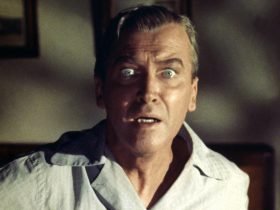
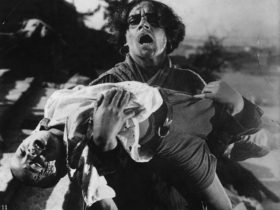

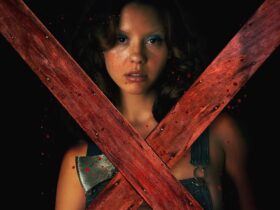
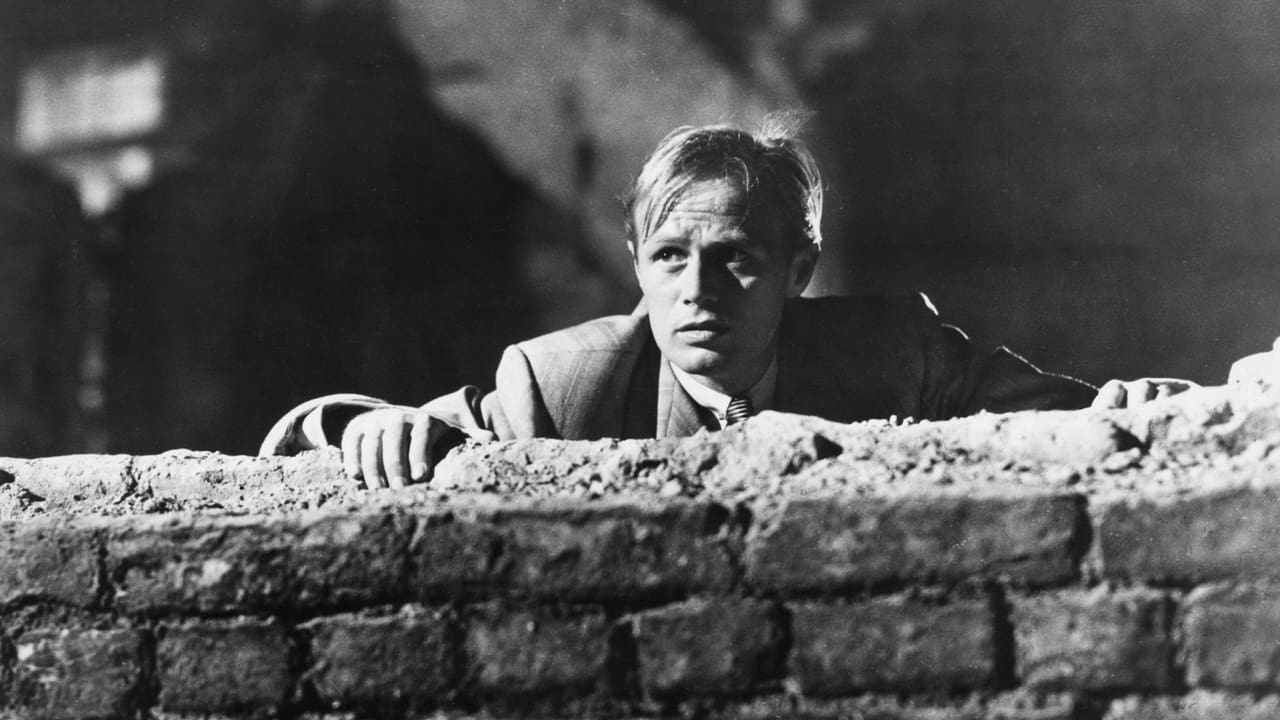



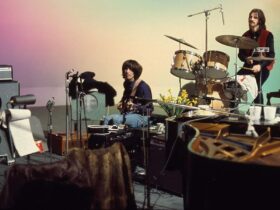
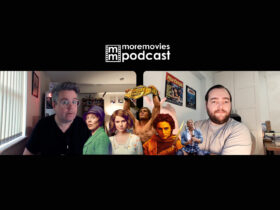
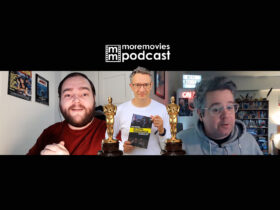
Leave a Reply